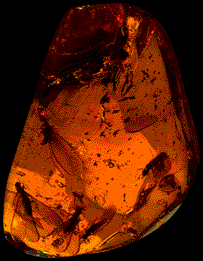



§ Amber is the fossilized remains of ancient
tree resin that was produced millions of years ago by now extinct
coniferous trees.
§ Amber can be further classified based on
its main constituents, and although the Classification system
presented has not yet been universally adopted, it has has been
used with some degree of success by many scientists.
| Derived from polymers of labdanoid diterpenes, including labdatriene COOH- acids, alcohol's and hydrocarbons, (Martin et al. 1974). | |
| Derived from polymers and copolymers of certain labdonoid diterpenes; normally including, but not limited to: Communic acid, communol and incorporating significant amounts of succinic acid. | |
| Essentially the same as Ia except biformene and related isomers are often included, and succinic acid is absent. | |
| Differently configured labdonoid diterpenes; often including, but not limited to: Ozoic acid, ozol and enantio biformenes, (and related isomers). | |
| Derived from polymers of bicyclic sesquiterpenoid hydrocarbons, especially cadiene, and related isomers, (Anderson et al. 1992). | |
| Natural (fossil) polystyrene, (Anderson et al. 1992). | |
| Fundamental structural character is apparently non-polymeric, especially incorporating sesquiterpenoids based in the cedrane carbon skeleton, (Anderson et al. 1992). | |
| Non-polymeric diterpenoid carboxylic acid, especially based on the abietane, pimarane, and isopimarane carbon skeletons, (Adams et al. 1970). |
§ A more general way of classifying amber is based on whether or not it contains succinic acid; succinites contain succinic acid whereas the other major group, the retinites do not, (Durham 1957).

